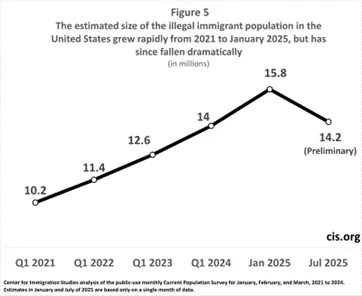Federal officials say the number of illegal immigrants in the United States has declined by roughly 2 million since President Donald Trump returned to the White House, marking one of the most significant enforcement shifts in recent decades.
Department of Homeland Security Assistant Secretary Tricia McLaughlin said that approximately 400,000 removals have been carried out directly by U.S. Immigration and Customs Enforcement and other federal agencies. At the same time, another 1.6 million individuals left the country voluntarily.
“We’re looking at about 2 million total in the past 240 days. That includes 1.6 million self-deportations, which we are very much encouraging illegal aliens to take,” McLaughlin said. “It’s a lot safer for the aliens themselves, for the public, for our law enforcement, and also it’s a lot better financially, a lot more tax savings for the U.S. taxpayer.”
McLaughlin emphasized that nearly 10% of the estimated 20 to 22 million illegal immigrants believed to be in the United States have departed since January. She also noted that the total was achieved under a budget set by the Biden administration before additional resources for ICE authorized under Trump’s “One Big, Beautiful Bill” were implemented.

The update aligns with recent findings from the Center for Immigration Studies and analysis of federal labor data. A review of the Bureau of Labor Statistics’ Current Population Survey showed an unprecedented 2.2 million decline in the overall foreign-born population between January and July. Researchers estimate that 1.6 million of that decline came from illegal immigrants, reducing the illegal immigrant population to about 14.2 million.
According to the survey, non-citizens accounted for the entire drop, while the naturalized U.S. citizen population slightly increased. The data also showed that employment among U.S.-born workers grew by 2.5 million during the same period, while the number of employed foreign-born individuals fell by 1 million. Analysts cautioned, however, that the Current Population Survey carries limitations, including potential underreporting by immigrants and preliminary estimates that could shift once more administrative data is available.
Despite those caveats, the independent data and DHS figures both point to a dramatic reduction in the illegal immigrant population within a short span of time. Federal officials say they expect deportation totals to rise further in the coming months as new ICE funding is rolled out.
McLaughlin said the administration remains confident that deportations and self-deportations will accelerate, with DHS aiming to meet Trump’s stated goal of cutting the illegal immigrant population significantly by the end of his term.



